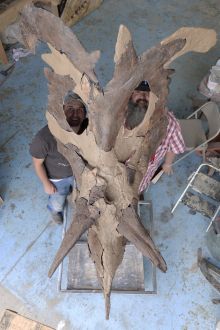U.S. National Science Foundation-funded researchers recently found a fossil that led to the discovery of a brand-new dinosaur species, Lokiceratops rangiformis. This horned dinosaur, an earlier relative of the triceratops, has asymmetric horns on top of its head but lacks the typical nose horn found in other relatives.
Fossils are the preserved remains, impressions or traces of any once-living thing from a past geologic age. Fossils can loosely be classified into two categories: body fossils and trace fossils. Body fossils, such as preserved bones, are preserved parts of the living creature. Trace fossils, such as footprints, record the activity of a living creature.
Lokiceratops rangiformis was discovered in northern Montana by a research team from the University of Utah. The team uncovered skull bones of Lokiceratops, which places this specimen in the body fossil category. These individual skull bones were painstakingly placed into a reconstruction of a complete skull. As more pieces were placed, the team began to see confirmation that they had discovered a whole new species of dinosaur.
This Science News article "Fantastic fossils and where to find them" was originally found on https://beta.nsf.gov/news/releases

